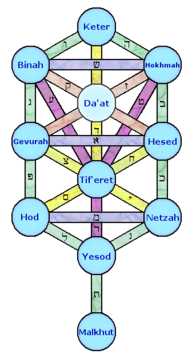- Tiferet
-
The Sefirot in Jewish Kabbalah 
Category:Sephirot Tiferet ("Adornment", Hebrew: תפארת [tiˈfeʔʁeθ]) or Tifaret, Tifereth, Tyfereth, Tiphereth is the sixth sefira in the Tree of Life in Kabbalah, which is the spirituality of Rabbinic Judaism. It has the common association of "Spirituality", "Balance", "Integration", "Beauty", "Miracles", "Compassion", and "Masculinity".
Contents
Description
In the Bahir it states: "Sixth is the adorned, glorious, delightful throne of glory, the house of the world to come. Its place is engraved in wisdom as it says 'God said: Let there be light, and there was light.'" [1]
Tiferet is the force that integrates the sefira of Khesed ("compassion") and Gevurah ("Overpowering"). These two forces are, respectively, expansive (giving) and restrictive (receiving). Either of them without the other could not manifest the flow of Divine energy; they must be balanced in perfect proportion (by sharing), and this is the role of Tiferet, wherein the conflicting forces are harmonized, and creation flowers forth.
Tiferet is unique amongst the Sephirot as it is connected to all the other Sephirot (except Malkuth) via the subjective paths of the unconscious. Its position down the center between Keter and Yesod indicates to many Kabbalists that it is somewhat of a "converting" Sephirot between form (Yesod) and force (Keter). In other words, all crossing over the middle path via Tiferet results in a reversed polarity. The law of conservation of energy and mass tends to corroborate this – in all cases of energy transmutation, a sacrifice is necessary so a new form may be born.
Tiferet is the middle of the tree. Five Sefirot surround it: above are Chesed at the right (south) and Gevurah at the left (north), and below are Netzach at the right, Hod at the left, and Yesod directly below. Together these six are a single entity, Zer Anpin, which is the masculine counterpart of the feminine sefira Malkuth. In certain contexts, Tiferet alone represents all the sefirot of Zer Anpin, so that the entire tree appears with only five sefirot: Keter, Chochmah, Binah, Tiferet, and Malkhut.
In the standard tree, Tiferet has eight paths, leading (counterclockwise) to Keter (through Daat), Binah, Gevurah, Hod, Yesod, Netsach, Chesed, and Chokmah.
Tiferet can be also a variation of the word "Tifarah" and in Modern Hebrew used in Israel is translated as "Glory" (from God – "Elohim, Adonay)
Non-Jewish associations
In Christian Cabala, Tiphereth is especially associated with Jesus Christ, 'God the Son' (as opposed to Kether, which is God the father, and Yesod, the Holy Spirit). This is because this is the Sephirah in which the divine force 'sacrifices' itself, transmutating into the forces of energy and matter, in order that creation might come to be. It is the sephirah in which 'God becomes a mortal man'. Illustrative of the process of Tipharet is Jesus' teaching in the book of John "No one comes to the Father except through me". Kether is raw energy as the Godhead and is as such unknowable by the conscious mind - Tiphareth (the son) balances the force and form of Kether and Yesod respectively allowing Kether to assume a knowable form. A Christian mystic, in relating to Jesus, repeats the process in the other direction, by transmutating that which is lower, in order to achieve the divine. In terms of the Kabbalah, Tipharet encompasses not only "God the Son" but also the related myths of Osiris and other sacrificial gods.
The archangel of this sphere is Raphael, and the Malakhim is the Angelic order.
Christianity primarily focuses on Tipharet as a driving spiritual force, emphasising the points of love, beauty, self sacrifice and service in its greater aspect. Particularly the Osirian sect and other derivations of pantheistic religions, with their personification of gods, emphasise the unknowable from the standpoint of Yesod. The eastern religions, particularly Taoism and Buddhism are more closely related to Kether, with their focus on unity and the indefinable aspect of the Divine.
Tiphereth is associated with divine love, with healing, balance and harmony. In comparing with Eastern traditions, Tiphereth is usually associated with the central Anahata chakra in tantric tradition, which contains many of the same archetypal ideas.
777 attributes Tiphereth as the four sixes of the tarot as well as the Princes and Emperors cards, Ra, Rama, Buddha, Apollo, Adonis, God the Son (Jesus), Phoenix, Lion, Bay, Laurel, Topaz, Lamen of he Rosy Cross, Abrahadabra, Coffee, and Alcohol.
References
- ^ Arthur Green. A guide to the Zohar
Jewish
- Bahir, translated by Aryeh Kaplan (1995). Aronson. (ISBN 1-56821-383-2)
- Lessons in Tanya
- Kabbalah 101: Tiferet
Non-Jewish
- 777, Aleister Crowley (1955). Red Wheel/Weiser. (ISBN 0-87728-670-1)
- The Mystical Kabbalah, Dion Fortune (1935). Weiser Books. (ISBN 1-57863-150-5)
Categories:
Wikimedia Foundation. 2010.

